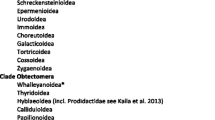Abstract
The skeleton and musculature of male genitalia were studied in species of a model butterfly group (subtribe Polyommatina, Lycaenidae). In total, we analyzed 45 species of the tribe Polyommatini most of which were previously used in the molecular phylogenetic study (Talavera et al., 2013). The studied morphological characters were mapped on the molecular trees, which allowed us to reveal trends of morphological changes and to estimate the age of their origin. As a result, chronology of evolution of skeleton and musculature traits was established. It was shown that periods of slow morphological evolution alternated in the subtribe Polyommatina with those of a high rate of origin of new traits. For example, topography of the intravalvar muscles has not changed for 26 MY preserving their initial fan-shaped attachment. The evolution of intravalvar muscles started 10 MYA, proceeded slowly during the first 5 MY, and then accelerated during the last 5 MY resulting in the extensive splitting of the musculature in most monophyletic lineages. Mapping the morphological characters on the phylogeny demonstrated that the rates of skeleton and muscle evolution within the skeleton/musculature apparatus were different. In most cases the intravalvar musculature evolved much faster than the skeleton. The cladistic interpretation of states of morphological traits was found to be consistent with phylogenetic reconstructions based on analysis of multiple molecular markers. Moreover, morphological synapomorphies were found for the lineages Alpherakya + Glabroculus and Aricia + (Alpherakya + Glabroculus), which had low statistical support in molecular phylogenetic analysis. Additionally, in some cases molecular studies helped to reveal trends in the evolution of morphological traits. For example, the unpaired uncus and the compact juxta are not plesiomorphic for Cupidina as previously thought; instead, they were shown to have evolved secondarily within this subtribe.
Similar content being viewed by others
References
Bálint, Z. and Johnson, K., “Reformation of the Polyommatus Section with Taxonomic and Biogeographic Overview (Lepidoptera, Lycaenidae, Polyommatini),” Neue Entomol. Nachr. 40, 1–68 (1997).
Drummond, A.J. and Rambaut, A., “BEAST: Bayesian Evolutionary Analysis by Sampling Trees,” BMC Evol. Biol. 7, 214 (2007).
Eliot, J., “The Higher Classification of the Lycaenidae: a Tentative Arrangement,” Bull. Brit. Mus. Nat. Hist. Entomol. Ser. 28(6), 373–505 (1973).
Kandul, N.P., Lukhtanov, V.A., Dantchenko, A.V., et al., “Phylogeny of Agrodiaetus Hübner 1822 (Lepidoptera: Lycaenidae) Inferred from mtDNA Sequences of COI and COII and Nuclear Sequences of EF1-α: Karyotype Diversification and Species Radiation,” Syst. Biol. 53, 278–298 (2004).
Kuznetzov, V.I., and Stekolnikov, A.A., “Evolution of Male Genital Skeleton and Muscles in the Families Riodinidae and Lycaenidae (Lepidoptera),” Entomol. Obozr. 77(2), 443–461 (1998) [Entomol. Rev. 78 (6), 691–705 (1998)].
Kuznetzov, V.I., and Stekolnikov, A.A., “New Approaches to the System of Lepidoptera of the World Fauna (Based on Abdominal Functional Morphology),” Trudy Zool. Inst. Ross. Akad. Nauk 282, 1–462 (2001).
Lukhtanov, V.A., “From Haeckel’s Phylogenetics and Hennig’s Cladistics to the Method of Maximum Likelihood: Advantages and Limitations of Modern and Traditional Approaches to Phylogeny Reconstruction,” Entomol. Obozr. 89(1), 133–149 (2010) [Entomol. Rev. 90 (3), 299–310 (2010)].
Lukhtanov, V.A., Kandul, N.P., Plotkin, J.B., et al., “Reinforcement of Pre-Zygotic Isolation and Karyotype Evolution in Agrodiaetus Butterflies,” Nature 436(7049), 385–389 (2005).
Megens, H.-J., Van Nes, W.J., Van Moorsel, C.H.M., et al., “Molecular Phylogeny of the Oriental Butterfly Genus Arhopala (Lycaenidae, Theclinae) Inferred from Mitochondrial and Nuclear Genes,” Syst. Entomol. 29(1), 115–131 (2008).
Mutanen, M., Wahlberg, N., and Kaila, L., “Comprehensive Gene and Taxon Coverage Elucidates Radiation Patterns in Moths and Butterflies,” Proc. R. Soc. (B) 277, 2839–2848 (2010).
Page, R.D.M. and Holmes, E.C., Molecular Evolution: a Phylogenetic Approach (Blackwell Publishing, Oxford, 1998).
Stekolnikov, A.A., “Phylogenetic Relations within Rhopalocera Inferred from the Functional Morphology of the Genital Apparatus,” Entomol. Obozr. 46(1), 3–24 (1967).
Stekolnikov, A.A., Morphological Principles of Musculature Evolution in Insects (St. Petersburg State Univ., St. Petersburg, 2008) [in Russian].
Stekolnikov, A.A., “Evolution of the Skeleton and Musculature of the Male Genitalia in the Family Lycaenidae (Lepidoptera): II. Infratribe Polyommatina Swainson, 1827,” Entomol. Obozr. 89(3), 561–587 (2010) [Entomol. Rev. 91 (1), 37–57 (2011)].
Stekolnikov, A.A. and Kuznetzov, V.I., “Evolution of Skeleton and Musculature of the Male Genitalia in the Family Lycaenidae (Lepidoptera): I. The Cupido, Glaucopsyche, Lycaenopsis, and Itylos Sections,” Entomol. Obozr. 84(4), 738–760 (2005) [Entomol. Rev. 85 (9), 1055–1073 (2005)].
Talavera, G., Lukhtanov, V.A., Pierce, N.E., and Vila, R., “Establishing Criteria for Higher-Level Classification Using Molecular Data: the Systematics of Polyommatus Blue Butterflies (Lepidoptera, Lycaenidae),” Cladistics 29, 166–192 (2013).
Wiemers, M., Chromosome Differentiation and the Radiation of the Butterfly Subgenus Agrodiaetus (Lepidoptera: Lycaenidae: Polyommatus)—a Molecular Phylogenetic Approach. PhD Thesis (Univ. Bonn, 2003).
Author information
Authors and Affiliations
Corresponding author
Additional information
Original Russian Text © A.A. Stekolnikov, V.A. Lukhtanov, A.I. Korzeev, 2013, published in Entomologicheskoe Obozrenie, 2013, Vol. 92, No. 3, pp. 517–536.
Rights and permissions
About this article
Cite this article
Stekolnikov, A.A., Lukhtanov, V.A. & Korzeev, A.I. Congruence between comparative morphology and molecular phylogenies: Evolution of the male genital skeletal/muscular system in the subtribe Polyommatina (Lepidoptera, Lycaenidae). Entmol. Rev. 94, 166–180 (2014). https://doi.org/10.1134/S0013873814020031
Received:
Published:
Issue Date:
DOI: https://doi.org/10.1134/S0013873814020031



